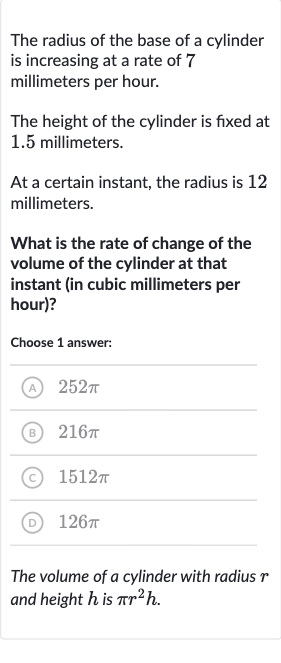AI tutor
Welcome to Bytelearn!
Let’s check out your problem:

The radius of the base of a cylinder is increasing at a rate of millimeters per hour.The height of the cylinder is fixed at . millimeters.At a certain instant, the radius is millimeters.What is the rate of change of the volume of the cylinder at that instant (in cubic millimeters per hour)?Choose answer:(A) (B) (C) (D) The volume of a cylinder with radius and height is .
Full solution
Q. The radius of the base of a cylinder is increasing at a rate of millimeters per hour.The height of the cylinder is fixed at . millimeters.At a certain instant, the radius is millimeters.What is the rate of change of the volume of the cylinder at that instant (in cubic millimeters per hour)?Choose answer:(A) (B) (C) (D) The volume of a cylinder with radius and height is .
- Volume Formula Derivation: The formula for the volume of a cylinder is . We need to find , the rate of change of volume with respect to time.
- Given Information: Given that (rate at which radius is increasing) and (height of the cylinder is constant).
- Differentiate Volume Formula: Differentiate the volume formula with respect to time: .
- Differentiate with respect to time: Now differentiate with respect to time: .
- Substitute Values: Substitute the values of and into the equation:
- Calculate : Now substitute and into the equation: mm mm/hour.
- Calculate : Now substitute and into the equation: .Calculate : .
More problems from Ratio and Quadratic equation
QuestionGet tutor help
